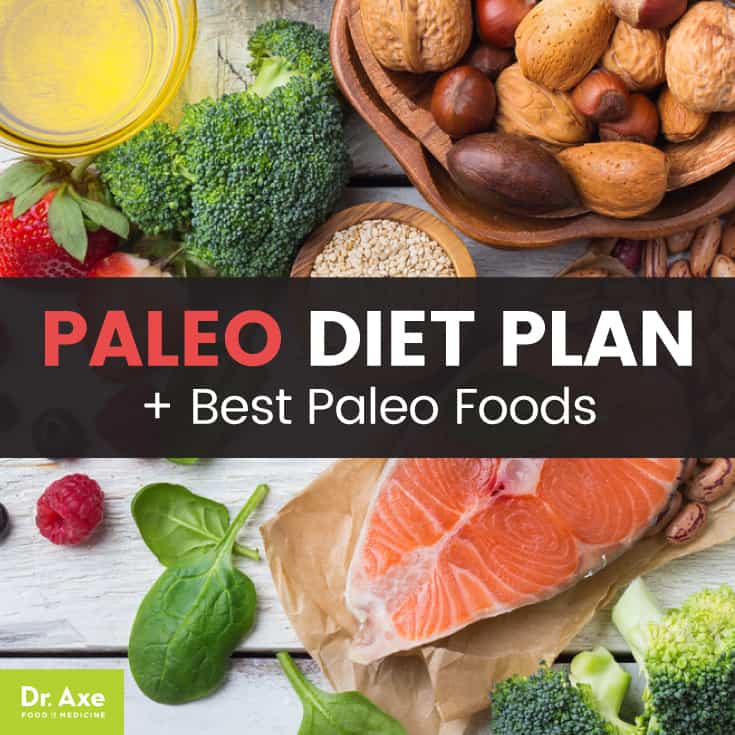
In the past few decades, our diets have changed dramatically. Processed foods are more common than fruits and vegetables, and it’s impossible to go more than a few miles down the road without spotting a dozen new fast food chains that have cropped up. Enter the Paleo diet plan, a diet that seeks to ditch the modern convenience foods in favor of the foods eaten by our ancestors.
Despite this, the Paleo diet plan remains one of the most popular diets today, and there is a massive community of people who swear by it, claiming that it can be a convenient, easy to follow and effective way to attain better health.
What Is a Paleo Diet?
The Paleo diet definition is simple: Eat only foods that were available to our hunter and gatherer ancestors thousands of years ago during the Paleolithic Age. This means that things like processed foods, refined grains and cereals are off the table, and instead your plate should be full of fruits and vegetables, meats, nuts and seeds.
The idea is that these are the foods that our bodies were designed to eat while many of the heavily processed modern foods that fill our diets today contribute to chronic disease and health problems. Proponents of the diet suggest that a well-planned Paleo diet could lead to improvements in many aspects of health, such as enhanced weight loss and reduced inflammation.
Because it is essentially a grain-free diet, it tends to be lower in carbohydrates and higher in protein and fat than some other diets. However, it also eliminates several food groups that contain beneficial nutrients, such as legumes and dairy, which has made this diet a subject of much debate among experts.
Keep reading to learn more about the pros and cons of the Paleo diet as well as how you should follow it to help maximize your results.
Why Try a Paleo Diet? 6 Paleo Diet Benefits
Promotes Weight LossHigh in ProteinReduces InflammationBoosts SatietyCorrects Nutrient DeficienciesRegulates Blood Sugar
1. Promotes Weight Loss
For many people, following the Paleo diet can result in a substantial amount of weight loss. By swapping processed foods and refined sugars for nutrient-rich proteins and healthy fats, you can cut calories and kick-start weight loss.
The specific foods included in the Paleo diet plan can also amp up weight loss. The plan encourages fruits and vegetables, which are high in slow-digesting fiber, along with healthy fats and protein, which increase satiety and reduce appetite.
Keep in mind that the amount of Paleo diet weight loss can vary depending on many factors, such as your what your diet was like beforehand. While some people may see the inches and pounds slide off after starting the Paleo diet, others may not see such dramatic results.
2. High in Protein
Getting enough protein in your diet is essential to maintaining overall health. Protein is vital for repairing and rebuilding tissue cells, maintaining normal blood sugar, transporting oxygen, healing wounds, and building muscle mass.
A protein deficiency can lead to a host of negative side effects, including low energy levels, decreased immunity, poor concentration and slow wound healing.
Protein is one of the staples of the Paleo diet plan. In fact, the plan encourages filling your plate with plenty of protein foods, such as grass-fed beef, poultry and seafood.
3. Reduces Inflammation
Inflammation is a normal bodily response triggered by the immune system to protect against foreign invaders. Prolonged or chronic inflammation, however, is at the root of most diseases, including chronic conditions like cancer, heart disease and diabetes.
The Paleo diet plan encourages eating plenty of anti-inflammatory foods, such as fruits, vegetables, nuts and seeds. Fruits and vegetables are high in antioxidants, which help neutralize the harmful free radicals that contribute to inflammation in the body. Meanwhile, nuts and seeds tend to be high in anti-inflammatory omega-3 fatty acids.
Reducing inflammation can also be beneficial in reducing symptoms of inflammatory or autoimmune conditions, such as rheumatoid arthritis, lupus or ulcerative colitis.
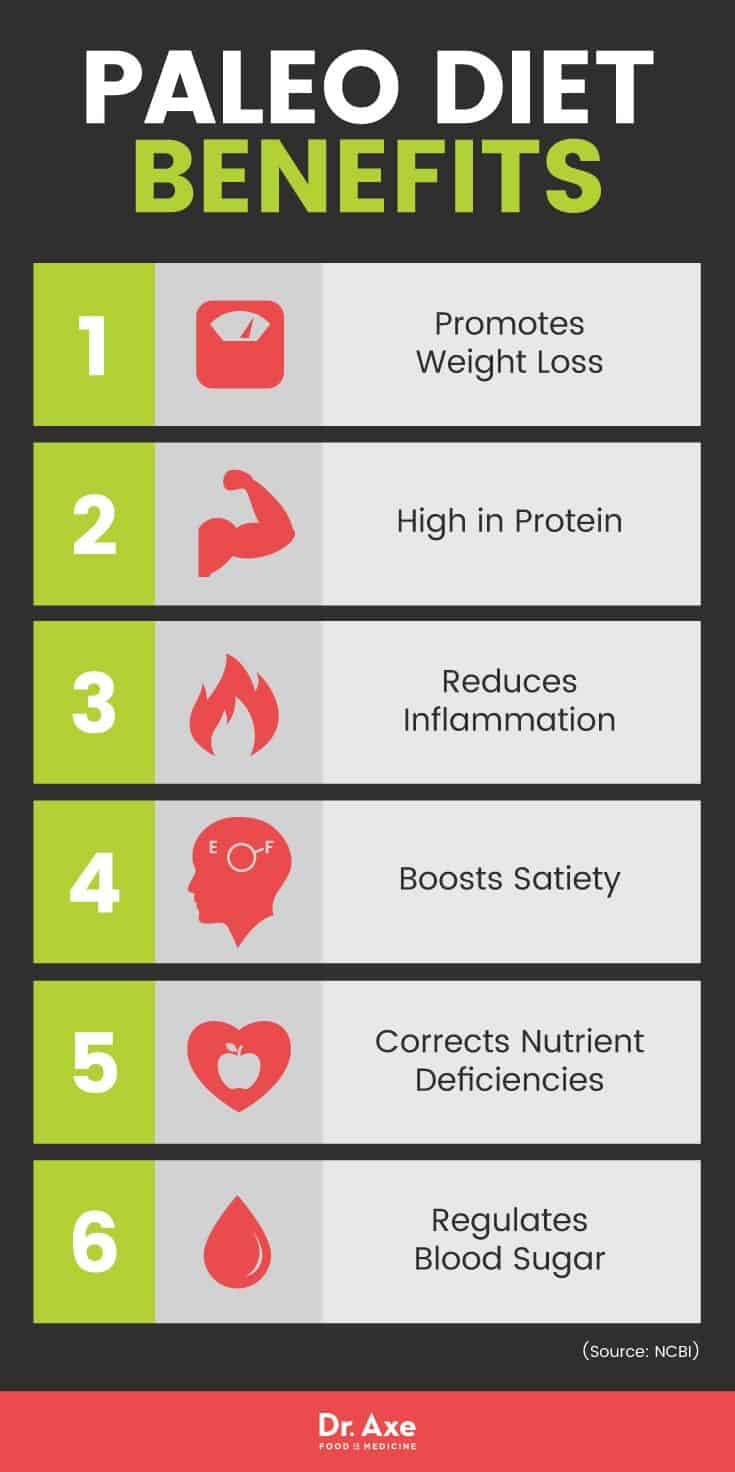
4. Boosts Satiety
The Paleo diet plan puts the emphasis on packing in plenty of heart-healthy fats and proteins into your diet, which can help support satiety and reduce appetite.
Fat is digested very slowly, so it stays in the stomach for longer and keeps you feeling full. Meanwhile, a high-protein diet can reduce levels of ghrelin, the hunger hormone, to reduce appetite. Protein has also been shown to kick-start your metabolism and decrease caloric intake.
Furthermore, the Paleo diet plan limits foods like refined grains and ultra-processed foods that are typically digested very quickly, leading to spikes and crashes in blood sugar levels as well as increased levels of hunger.
5. Corrects Nutrient Deficiencies
One of the biggest benefits of the Paleo diet is that it prioritizes nutrient-dense foods over heavily processed or refined foods. These foods can supply important micronutrients that you may be missing from your diet, helping reduce a wide range of symptoms, from brain fog to chronic fatigue.
Increasing your intake of red meat, for instance, can provide more iron while adding more nuts and seeds into your diet can up your intake of omega-3 fatty acids.
If you have any nutrient deficiencies and are currently consuming a diet rich in “empty calories” from nutrient-poor foods like junk food, switching to a Paleo diet may help you fit more nutrients into your diet.
6. Regulates Blood Sugar
While not as extreme as a very low- or no-carb diet, the Paleo diet does restrict many types of carbohydrates, such as cereal grains. This may positively impact your blood sugar levels. The diet also emphasizes nutrients like fat and protein, which are digested slowly, keeping blood sugar levels stable.
A study published in the European Journal of Clinical Nutrition compared the benefits of following a Paleo diet versus a diet recommended by the American Diabetes Association in 24 participants with diabetes. After two weeks, researchers found that the Paleo diet led to greater improvements in blood sugar levels and insulin sensitivity than the conventional diabetes diet.
Of course, lifestyle factors also play an important role in diabetes prevention. In addition to making dietary modifications, exercising regularly, reducing stress levels and drinking plenty of water can also help you maintain normal blood sugar.
Paleo Diet Plan Guide
Looking for a resource on the Paleo diet for beginners? Look no further. In this comprehensive Paleo diet plan guide, you’ll find some quick tips for maximizing your success on the Paleo diet, which Paleo diet foods you should include or avoid on the plan, and some tasty recipes to get you started.
Trying a 30-day Paleo meal plan can help you decide if the Paleo diet is right for you and if it can help you achieve your goals — whether that includes weight loss, increased energy or simply overall better health.Print out a list of healthy Paleo foods, and bring it with you to the grocery store for an easy reference. Look for organic fruits and vegetables and unprocessed foods with minimal added ingredients to ensure you’re getting the best quality.Although there are plenty of Paleo meal plan delivery sites out there, doing your own grocery shopping and preparing your meals at home can give you more control over your diet.It can be easy to load your diet up with fried bacon and butter and still be technically following a Paleo diet plan. However, to get the most from the Paleo diet, opt for lots of fruits and vegetables, unprocessed meat, poultry and seafood, and heart-healthy fats, along with a few servings of seafood per week.Eat when you feel hungry, and don’t worry about counting calories or macronutrients. The idea is to do what feels most natural to you and listen to your body.Any diet should be paired with a healthy lifestyle to maximize results. Exercise regularly, reduce your stress levels, stay well-hydrated and avoid unhealthy habits and you’ll be much more likely to achieve your health goals with the Paleo diet plan.
Best Paleo Foods
Following the Paleo diet plan can be a bit tricky as it can be challenging to know which foods you should include in your diet and which foods you should avoid. Here is a healthy Paleo diet food list with some foods that you should include in your diet:
Grass-fed beef SeafoodPoultryFresh fruitsFresh vegetablesEggsNuts and seedsHeart-healthy unrefined oils, such as olive, coconut, flaxseed, walnut and avocado oil
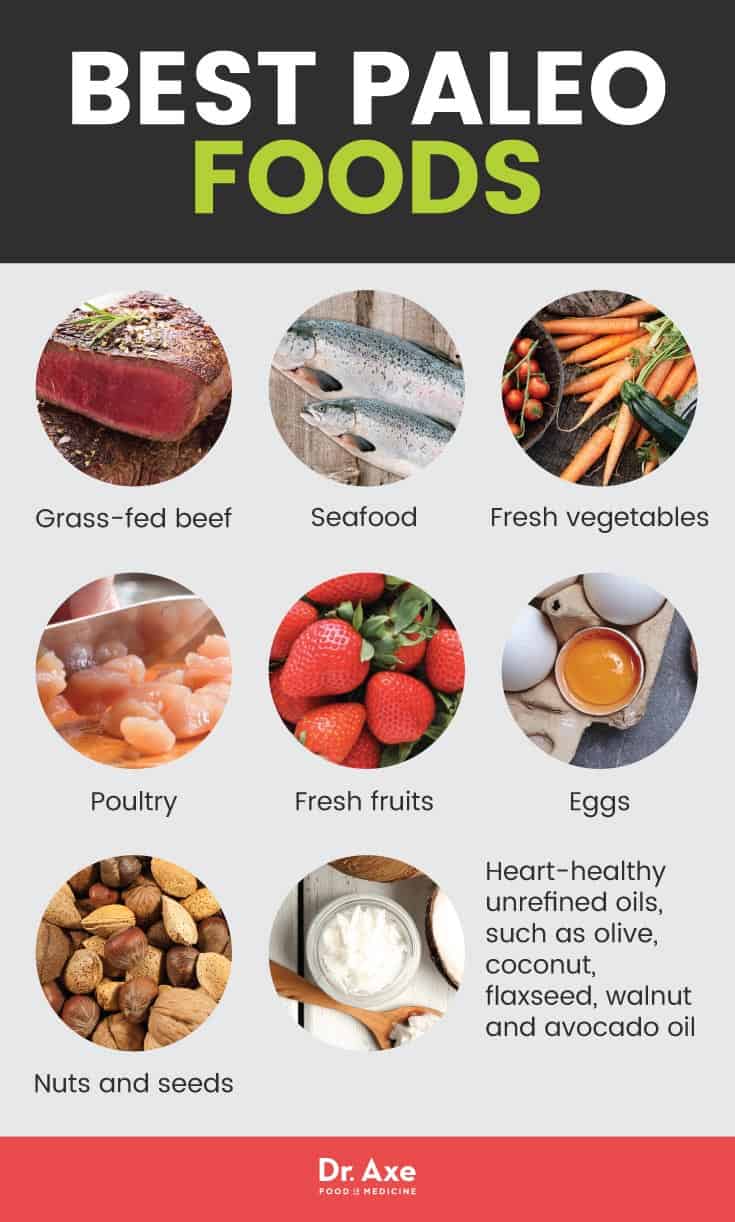
Foods to Avoid on the Paleo Diet Plan
Just as important as knowing which Paleo diet food groups you can enjoy is knowing which ones you should cut out of your diet. Here are the foods that you should avoid while following a Paleo diet plan:
Legumes (including beans and peanuts) DairyRefined sugar Refined vegetable oilsProcessed/junk foodWhite potatoesCereal grainsSugar-sweetened or caffeinated beverages
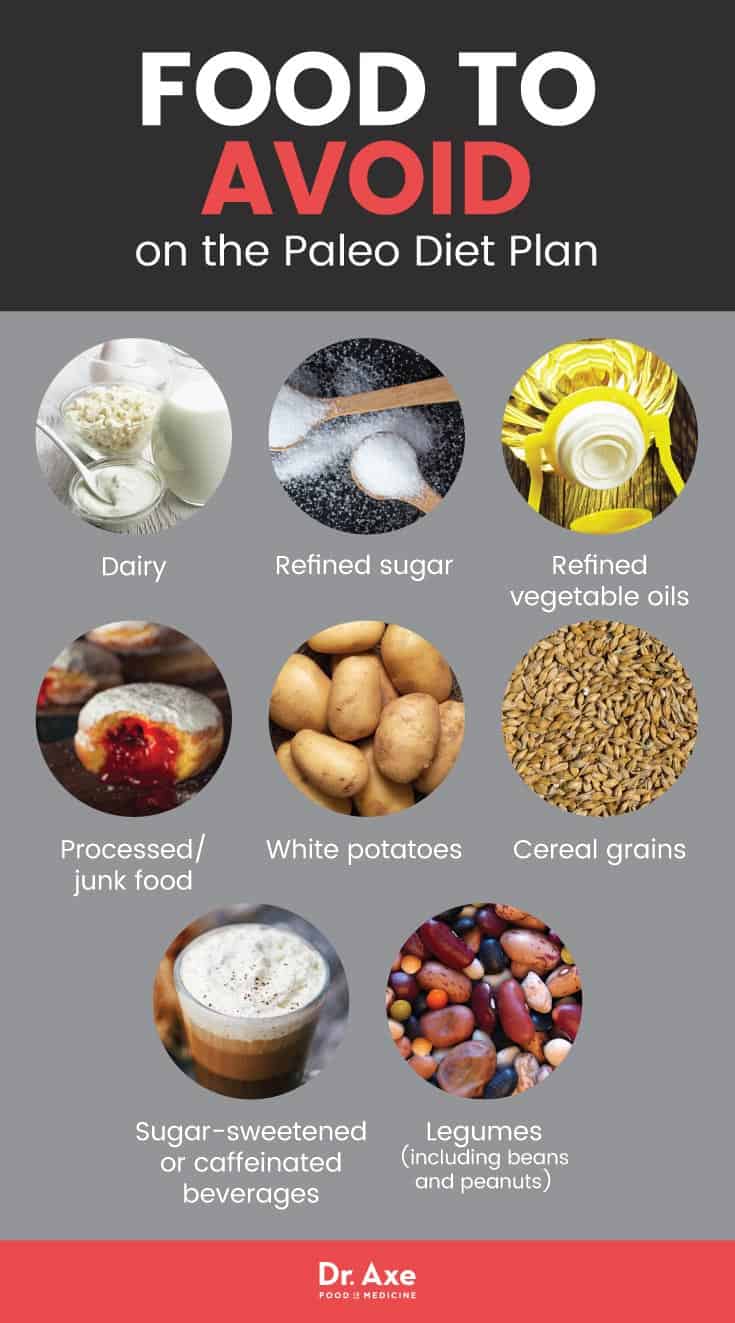
Downsides to a Paleo Diet Plan
While the Paleo diet plan may come with several benefits to health, there are also some downsides that should be taken into consideration as well.
First of all, it’s unclear if it can really live up to its claim to improve overall health by following the diet of our ancestors. While we can all benefit from reducing our intake of processed foods and increasing fruit and vegetable consumption, many dispute whether our ancestors were really all that much healthier than we are today given their significantly shorter life span. In fact, one study even demonstrated that they may have had increased rates of atherosclerosis, or hardened arteries.
The Paleo diet also restricts many foods that are loaded with beneficial nutrients. Legumes, for instance, are high in fiber and protein as well as micronutrients like iron, magnesium, potassium and folate. Dairy can also be a positive dietary addition as it provides calcium, phosphorus and vitamin D.
Additionally, the Paleo diet puts a heavy emphasis on meat products. For this reason, the Paleo diet may not be suitable for everyone, and you’re unlikely to find a Paleo diet vegetarian or vegan modification out there. While meat in moderation is perfectly healthy, excessive meat consumption may not be. A high intake of red meat, for example, has been linked to an increased risk of mortality and colorectal cancer.
There are also certain Paleo diet foods allowed on the plan that are not great for health. Pork, for example, carries a higher risk of parasites while shrimp often contains unhealthy chemicals and additives. These foods are allowed on the Paleo diet without restriction, but their intake should be moderated on a health-promoting diet.
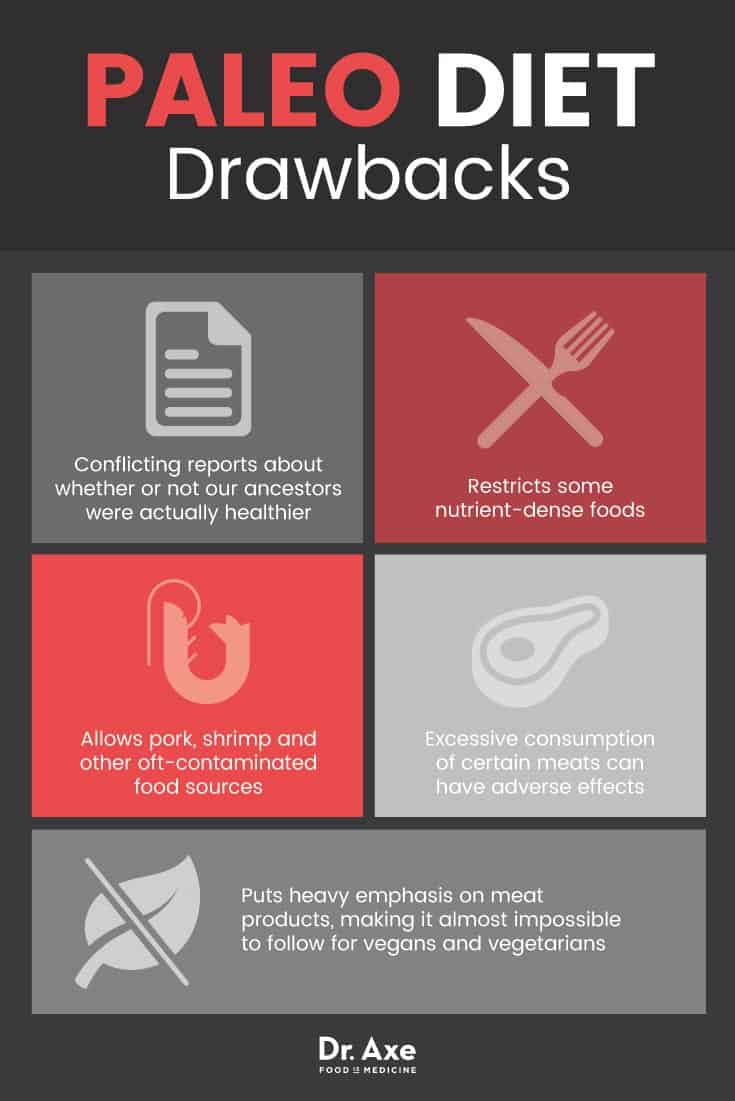
Paleo Diet Recipes
Wondering what a typical day on a Paleo diet looks like? There are plenty of recipes out there for everything from Paleo desserts to dinners, but here are a few simple Paleo diet recipes to get you started:
Banana Egg
Brownies with Dark Chocolate Chips
Paleo Diet Plan History
The Paleo diet can be traced back to gastroenterologist Walter Voegtlin, who brought up the idea of eating like our ancestors in 1975 in his book “The Stone Age Diet.” A decade later, researchers Melvin Konner and Stanley Boyd Eaton published a paper on the paleo diet in the New England Journal of Medicine, which is considered one of the foundations of the Paleo diet as we know it today.
However, scientist Dr. Loren Cordain is most often credited with founding the modern paleo movement when he wrote “The Paleo Diet” in 2002 along with a multitude of other books on the Paleo diet in the following years.
It wasn’t until the last five or six years that the Paleo diet really started to catch on, though. By 2013, it was ranked as the most searched weight loss method on Google. Today, the Paleo diet remains one of the most popular diets and has a huge fan base of dedicated followers that enjoy the flexibility and health benefits it provides.
Precautions with the Paleo Diet Plan
Because the Paleo diet cuts out many food groups, it is not suitable for vegans, vegetarians or those with any major dietary restrictions as it may be challenging to meet nutrient needs.
Keep in mind that not all Paleo foods are healthy. For example, while fried bacon and conventional butter may be Paleo-friendly, include these foods only in moderation. Instead, fill your diet with lots of fruits and vegetables, nuts, seeds, lean sources of protein, and heart-healthy fats to get the most from the Paleo diet.
If you have diabetes, you should consult with your doctor before making any major dietary changes. Reducing your carb intake on the Paleo diet may require you to alter your dosage of diabetes medications to avoid fluctuations in blood sugar levels.
Finally, listen to your body. If you experience any prolonged negative symptoms after switching to a Paleo diet, talk to your doctor or dietitian to make sure you don’t have any nutritional gaps that need to be filled in your diet.
Final Thoughts on the Paleo Diet Plan
What is the Paleo diet? This popular diet is based on eating the same foods that were available to our ancestors in the Paleolithic era.Legumes, dairy, cereal grains and processed foods are the main food groups eliminated from the Paleo diet. Instead, it emphasizes meat, poultry and seafood, fruits and vegetables, nuts, seeds, and heart-healthy fats.Potential health benefits of the diet plan include increased weight loss, reduced inflammation, increased satiety and stable blood sugar levels. It also promotes nutrient-dense and high-protein foods, which can support improved health.There are also some negative aspects of the diet. Not only is the Paleo diet difficult to follow if you have any dietary restrictions, but the Paleo diet also eliminates several nutrient-rich food groups while allowing several unhealthy foods.There are plenty of healthy Paleo diet recipes out there, including Paleo snacks, meals and desserts, making it easier than ever to follow the diet plan.
Disclamer:
Paleo Diet Plan History
The Paleo diet can be traced back to gastroenterologist Walter Voegtlin, who brought up the idea of eating like our ancestors in 1975 in his book “The Stone Age Diet.” A decade later, researchers Melvin Konner and Stanley Boyd Eaton published a paper on the paleo diet in the New England Journal of Medicine, which is considered one of the foundations of the Paleo diet as we know it today.
However, scientist Dr. Loren Cordain is most often credited with founding the modern paleo movement when he wrote “The Paleo Diet” in 2002 along with a multitude of other books on the Paleo diet in the following years.
It wasn’t until the last five or six years that the Paleo diet really started to catch on, though. By 2013, it was ranked as the most searched weight loss method on Google. Today, the Paleo diet remains one of the most popular diets and has a huge fan base of dedicated followers that enjoy the flexibility and health benefits it provides.
Precautions with the Paleo Diet Plan
Because the Paleo diet cuts out many food groups, it is not suitable for vegans, vegetarians or those with any major dietary restrictions as it may be challenging to meet nutrient needs.
Keep in mind that not all Paleo foods are healthy. For example, while fried bacon and conventional butter may be Paleo-friendly, include these foods only in moderation. Instead, fill your diet with lots of fruits and vegetables, nuts, seeds, lean sources of protein, and heart-healthy fats to get the most from the Paleo diet.
If you have diabetes, you should consult with your doctor before making any major dietary changes. Reducing your carb intake on the Paleo diet may require you to alter your dosage of diabetes medications to avoid fluctuations in blood sugar levels.
Finally, listen to your body. If you experience any prolonged negative symptoms after switching to a Paleo diet, talk to your doctor or dietitian to make sure you don’t have any nutritional gaps that need to be filled in your diet.
Final Thoughts on the Paleo Diet Plan
What is the Paleo diet? This popular diet is based on eating the same foods that were available to our ancestors in the Paleolithic era.Legumes, dairy, cereal grains and processed foods are the main food groups eliminated from the Paleo diet. Instead, it emphasizes meat, poultry and seafood, fruits and vegetables, nuts, seeds, and heart-healthy fats.Potential health benefits of the diet plan include increased weight loss, reduced inflammation, increased satiety and stable blood sugar levels. It also promotes nutrient-dense and high-protein foods, which can support improved health.There are also some negative aspects of the diet. Not only is the Paleo diet difficult to follow if you have any dietary restrictions, but the Paleo diet also eliminates several nutrient-rich food groups while allowing several unhealthy foods.There are plenty of healthy Paleo diet recipes out there, including Paleo snacks, meals and desserts, making it easier than ever to follow the diet plan.
Disclamer:
The information in our articles are NOT intended to replace a one-on-one relationship with a qualified health care professional and are not intended as medical advice.
It is a very healthy diet plan. The ingredients use in this a re very healthy. The lifestyles becomes very good. I like this article very much. Thankyou for sharing. Now its time to avail Best 10 seat minibus hire in Dartford for more information.
ReplyDeleteThe article is important to relate to human health. Very valid and useful diets point discussed in article. I hope you share more important blog on diet. Now it's time to avail same day computer repair in Essex, MD for more information.
ReplyDeletehey
ReplyDeleteArthritis and Pain Management Clinic offers specialized treatments to manage chronic pain and improve joint health for arthritis patients.
ReplyDeleteGyFTR is a top digital gifting platform offering instant e-gift vouchers for leading brands, including Myntra Gift Card Code and Skechers gift cards. With seamless redemption, exclusive discounts, and instant delivery, GyFTR makes gifting effortless for personal and corporate needs. Enjoy a secure and hassle-free experience.
ReplyDelete11xplay stands out as a trusted online gaming platform offering diverse games like slots, poker, and live casino action. With secure payments and responsive customer support, players can enjoy a hassle-free gaming experience anytime. Regular bonuses, user-friendly design, and fast withdrawals make 11xplay a top choice for gaming enthusiasts. Discover non-stop entertainment and big winning chances with 11xplay!
ReplyDeleteCricbet99 is an online sports betting platform offering cricket, casino, and live games with easy registration, secure transactions, and exciting gaming experiences for users.
ReplyDelete